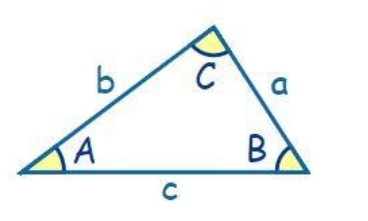
In a triangle ABC, sin A : sin B : sin C =1 : 2 : 3. Find the perimeter of the triangle if b = 4cm.
(a) 6 cm
(b) 24 cm
(c) 12 cm
(d) 8 cm
Answer
607.2k+ views
Hint: To find the perimeter, we make use of sine rule, to find the values of a and c. Then we can calculate the perimeter of the triangle by adding a, b and c.

Complete step-by-step answer:
To explain further now, we will refer to the triangle above. The sides a, b and c represent the sides opposite angles A, B and C (as shown in the triangle above). In the question, we are already given that b = 4cm. Thus, all we have to do is calculate the value of a and c.
To do so, we use the sine rule. By sine rule, we have,
$\dfrac{a}{\sin A}=\dfrac{b}{\sin B}=\dfrac{c}{\sin C}=k$
Thus, we have,
a=k$\sin A$ -- (1)
b=k$\sin B$-- (2)
c=k $\sin C$-- (3)
From the question, we also have,
$\sin A:\sin B:\sin C$=1:2:3
Thus, $\dfrac{\sin A}{\sin B}=\dfrac{1}{2}$
Also,
$\begin{align}
& \dfrac{\sin B}{\sin C}=\dfrac{2}{3} \\
& \dfrac{\sin C}{\sin B}=\dfrac{3}{2} \\
\end{align}$
We will use these results in the below calculations-
Now, we divide (1) by (2), we get,
$\begin{align}
& \dfrac{a}{b}=\dfrac{\sin A}{\sin B} \\
& a=b\times \dfrac{\sin A}{\sin B} \\
& a=4\times \dfrac{1}{2} \\
& a=2 \\
\end{align}$
Now, we divide (2) by (3), we get,
$\begin{align}
& \dfrac{b}{c}=\dfrac{\sin B}{\sin C} \\
& c=b\times \dfrac{\sin C}{\sin B} \\
& c=4\times \dfrac{3}{2} \\
& c=6 \\
\end{align}$
Now, since we have the values of a, b and c. We are now ready to calculate the perimeter of the triangle. Thus,
Perimeter = a+b+c
Perimeter = 2+4+6
Perimeter = 12 cm
Hence, the correct answer is (c) 12 cm.
Note: Although not mentioned in the question, as a general rule, it is important to remember that a, b and c are sides to the angles A, B and C respectively. Further, to get the intuition of using sine rule, one can get a hint of this from the sine ratios of various angles given in the question. Whenever such a ratio is given, it is always better to use the sine rule to solve the problem.

Complete step-by-step answer:
To explain further now, we will refer to the triangle above. The sides a, b and c represent the sides opposite angles A, B and C (as shown in the triangle above). In the question, we are already given that b = 4cm. Thus, all we have to do is calculate the value of a and c.
To do so, we use the sine rule. By sine rule, we have,
$\dfrac{a}{\sin A}=\dfrac{b}{\sin B}=\dfrac{c}{\sin C}=k$
Thus, we have,
a=k$\sin A$ -- (1)
b=k$\sin B$-- (2)
c=k $\sin C$-- (3)
From the question, we also have,
$\sin A:\sin B:\sin C$=1:2:3
Thus, $\dfrac{\sin A}{\sin B}=\dfrac{1}{2}$
Also,
$\begin{align}
& \dfrac{\sin B}{\sin C}=\dfrac{2}{3} \\
& \dfrac{\sin C}{\sin B}=\dfrac{3}{2} \\
\end{align}$
We will use these results in the below calculations-
Now, we divide (1) by (2), we get,
$\begin{align}
& \dfrac{a}{b}=\dfrac{\sin A}{\sin B} \\
& a=b\times \dfrac{\sin A}{\sin B} \\
& a=4\times \dfrac{1}{2} \\
& a=2 \\
\end{align}$
Now, we divide (2) by (3), we get,
$\begin{align}
& \dfrac{b}{c}=\dfrac{\sin B}{\sin C} \\
& c=b\times \dfrac{\sin C}{\sin B} \\
& c=4\times \dfrac{3}{2} \\
& c=6 \\
\end{align}$
Now, since we have the values of a, b and c. We are now ready to calculate the perimeter of the triangle. Thus,
Perimeter = a+b+c
Perimeter = 2+4+6
Perimeter = 12 cm
Hence, the correct answer is (c) 12 cm.
Note: Although not mentioned in the question, as a general rule, it is important to remember that a, b and c are sides to the angles A, B and C respectively. Further, to get the intuition of using sine rule, one can get a hint of this from the sine ratios of various angles given in the question. Whenever such a ratio is given, it is always better to use the sine rule to solve the problem.
Recently Updated Pages
Master Class 9 Social Science: Engaging Questions & Answers for Success

Master Class 9 Science: Engaging Questions & Answers for Success

Master Class 9 English: Engaging Questions & Answers for Success

Master Class 9 Maths: Engaging Questions & Answers for Success

Master Class 9 General Knowledge: Engaging Questions & Answers for Success

Class 9 Question and Answer - Your Ultimate Solutions Guide

Trending doubts
Which places in India experience sunrise first and class 9 social science CBSE

Fill the blanks with the suitable prepositions 1 The class 9 english CBSE

Write the 6 fundamental rights of India and explain in detail

Difference Between Plant Cell and Animal Cell

What is pollution? How many types of pollution? Define it

What is the Full Form of ISI and RAW




